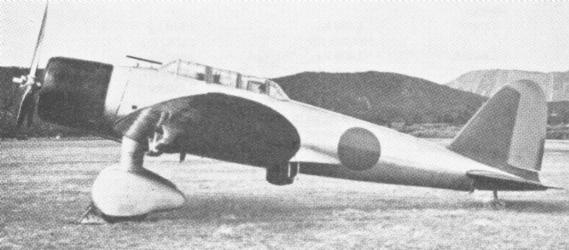|
Air Power |
The Japanese navy, in the summer of 1936, issued a specification call (II-Shi) for a carrier-based airplane with dive-bombing capabilities. The specifications called for a monoplane design. As usual, the leading manufacturers submitted designs. Mitsubishi, Nakajima, and Aichi received contracts to build prototypes.
After tests were completed, the Aichi company was ready to compete for the contract. One unusual characteristic of the Val was its fixed and spatted undercarriage -- the fixed landing gear added weight and decreased performance, but actually added stability to this particular design.
A second prototype was constructed with the enlargement of the wings, tail and stabilizers. An increased powerplant capacity was fulfilled by the addition of a Mitsubishi Kinsei No. 3, a 14-cylinder air-cooled radial engine. As with the first prototype, the aircraft carried two seats, one for the pilot and one for the rear gunner/radio operator.
It was later found that, because the aircraft was so maneuverable, the Val could be used as a fighter plane despite the light armament of two 7.7mm Type 97 machine guns (mounted on the engine cowling) and one flexible 7.7mm Type 92 rear-mounted machine gun.
The Val carried a 250kg (551-pound) bomb under the fuselage that was released via a swing arm. In addition, two 60kg (132- pound) bombs could be carried on racks under each wing.
Carrier qualification trials were held aboard the AKAGI and KAGA in 1940 with satisfactory results. Vals saw limited action in China in the year preceding the attack on Pearl Harbor.
Historians for the most part agree that the first bombs to fall at Pearl Harbor came from Lt. Commander Kakiuchi Takahashi's attack group of dive bombers that struck the PBY ramp at Ford Island. For the AICHI Vals, the day proved successful but costly -- a majority of the 29 aircraft lost were Vals.
Like the NAKAJIMA Kate, the Val enjoyed early success in the war but by 1944 it was suffering heavy losses and was outperformed by allied aircraft. As the war drew to a close, the AICHI D3A1 Val was pressed into Kamikaze units.
Additional comments:
When the Japanese launched their surprise attack on December 7, 1941 against Pearl Harbor, the Aichi D3A1 became the first Japanese aircraft to drop bombs on American targets.
This aircraft sank more allied ships and more shear tonnage than any other Axis aircraft in WWII.
Specifications:
Type: Carrier based dive bomber
Allied Codename: Val
Crew: Two
Production: Around 1,500 total (D3A2: 1,016)
Powerplant:
D3A1 (Early):
- Model: Mitsubishi Kinsei 43
- Type: Radial piston
- Number: One - Horsepower: 1,000 hp
D3A1 (Later):
- Model: Mitsubishi Kinsei 44
- Type: Radial piston
- Number: One - Horsepower: 1,070 hp
D3A2 Model 12:
- Model: Mitsubishi Kinsei 54
- Type: Radial piston
- Number: One - Horsepower: 1,300 hp
Dimensions:
Wing Span: 47 ft. 2 in. (14.38m)
Length: 33 ft. 5.375 in. (10.2m)
Height: 12 ft. 7½ in. (3.85m)
Wing Area: 375.7 sq ft. (34.9 m²)
Weights:
Empty:
- D3A1: 5,309 lb. (2408 kg)
- D3A2: 5,666 lb. (2570 kg)
Max. Take-Off:
- D3A1: 8,047 lb. (3650 kg)
- D3A2: 8,378 lb. (3800 kg)
Performance:
Maximum Level Speed:
- D3A1: 239 mph (385 km/h) at 9,840 ft.
- D3A2: 267 mph (430 km/h) at 20,340 ft.
Cruising Speed:
- D3A1: 183 mph (295 km/h) at 9,840 ft.
Service Ceiling:
- D3A1: 30,150 ft. (9300 m)
- D3A2: 34,450 ft. (10500 m)
Climb to 9,840 ft.: 6 Minutes 25 Seconds
Max. Range:
- D3A1: 913 miles (1470 km)
- D3A2: 840 miles (1352 km)
Armament:
Two 7.7-mm (0.303-in) Type 97 machine guns in wings.
One 7.7-mm (0.303-in) Type 92 machine gun in rear cockpit.
Payload:
One 551 lb. (250 kg) and two 132 lb (60 kg) bombs 


All photos Copyright of:
War Bird Resource Group
Aviation History.com
Ken's Aviation
